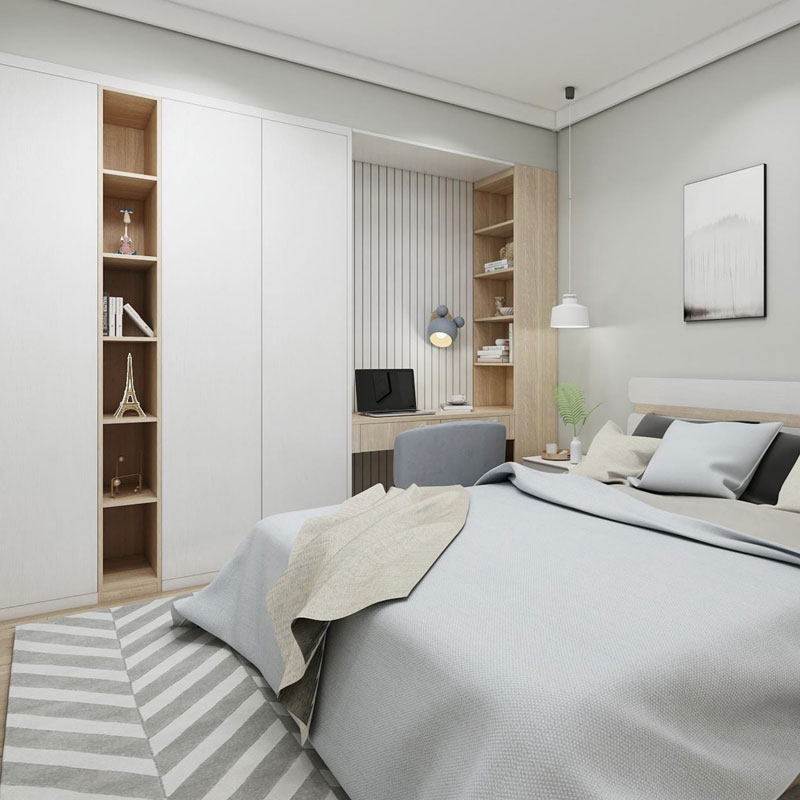How Do Wardrobe Closets Transform Modern Living Spaces?
2025-09-16
Storage has always been a cornerstone of home design, but in today’s fast-paced world, the need for efficient, functional, and stylish solutions has grown more urgent. A wardrobe closet is more than just a container for clothes; it is a vital element of interior organization that influences both lifestyle and aesthetics. From compact city apartments to spacious suburban homes, wardrobe closets bring order, elegance, and convenience to daily routines.
At its core, a wardrobe closet is designed to store clothing, shoes, and accessories in a structured way. Yet its role has expanded far beyond that simple function. It contributes to:
-
Optimized living space: By reducing clutter and maximizing vertical storage.
-
Improved time management: Easy organization means less time wasted searching for clothes.
-
Enhanced interior design: A wardrobe closet can complement décor and add value to property.
-
Personal expression: With customizable finishes, layouts, and materials, it reflects individual style.
The evolution of wardrobe closets demonstrates how functionality and design merge. Modern closets incorporate sliding doors for space-saving, modular shelving for flexibility, and sustainable materials for eco-conscious households. They are no longer hidden corners of the home but statement pieces that improve lifestyle quality.
How Do Wardrobe Closets Adapt to Different Lifestyles?
One of the defining strengths of wardrobe closets is their versatility. They are not one-size-fits-all solutions but rather adaptable systems that can be customized for diverse user needs. Whether you are a professional with a business wardrobe, a family with children, or a fashion enthusiast with a large collection, wardrobe closets can be tailored to deliver maximum utility.
Common Types of Wardrobe Closets
-
Freestanding Wardrobes
-
Ideal for renters or those seeking mobility.
-
Flexible placement, no permanent installation required.
-
-
Built-in Wardrobes
-
Integrated into walls for a seamless appearance.
-
Saves space and enhances the flow of interior design.
-
-
Sliding Door Wardrobes
-
Suitable for small rooms where hinged doors take up space.
-
Smooth operation and modern aesthetics.
-
-
Walk-in Closets
-
Luxury storage for larger homes.
-
Offers dedicated space for clothes, shoes, jewelry, and accessories.
-
-
Corner Wardrobes
-
Maximize otherwise unused spaces.
-
Smart design for compact homes or offices.
-
Technical Parameters of Wardrobe Closets
Wardrobe closets differ widely in construction and performance features. Below is a summary of typical product parameters:
| Parameter | Specification Options |
|---|---|
| Material | Solid wood, MDF, plywood, laminate, metal frame, glass panels |
| Dimensions | Standard: 2000–2500 mm height, 800–2500 mm width, 600 mm depth |
| Door Types | Hinged, sliding, folding, frameless glass |
| Internal Layout | Hanging rods, adjustable shelves, drawers, shoe racks, mirrors |
| Finish Options | Veneer, lacquer, melamine, matte, glossy, mirrored |
| Customization | Modular designs for accessories, lighting, locks |
| Durability | Load-bearing up to 50–100 kg per shelf, long-term wear resistance |
These specifications ensure that customers can select wardrobes tailored to their practical needs while still aligning with their interior design preferences.
Advantages Across Different Lifestyles
-
For families: Adjustable shelves grow with children’s needs.
-
For professionals: Specialized compartments protect suits and shoes.
-
For fashion lovers: Walk-in closets allow for display and easy access.
-
For compact homes: Sliding doors and modular units maximize floor space.
How to Choose the Right Wardrobe Closet for Your Home?
Selecting the right wardrobe closet requires careful evaluation of both functional and aesthetic factors. A poorly chosen design can lead to wasted space, storage inefficiency, or even premature wear and tear. On the other hand, a well-planned wardrobe closet enhances daily routines and adds sophistication to the home.
Key Considerations Before Purchase
-
Available Space
-
Measure the room dimensions and consider ceiling height.
-
Choose sliding doors for tight spaces or walk-ins for large rooms.
-
-
Storage Requirements
-
Assess the volume of clothes, shoes, and accessories.
-
Identify special storage needs (e.g., long dresses, sports gear, jewelry).
-
-
Material Durability
-
Solid wood offers longevity and a premium look.
-
Laminates and MDF provide cost-effective yet durable alternatives.
-
-
Design Aesthetics
-
Match wardrobe finishes to wall colors, flooring, and furniture.
-
Glass doors or mirrored finishes can make smaller rooms appear larger.
-
-
Budget and Longevity
-
Balance upfront investment with expected lifespan.
-
Consider modular solutions that allow upgrades over time.
-
Benefits of the Right Choice
-
Efficiency: Maximizes use of space and reduces clutter.
-
Durability: Ensures long-lasting furniture that withstands daily use.
-
Comfort: Smooth functionality with ergonomic layouts.
-
Value: Enhances property resale value through modern interior appeal.
Common FAQs About Wardrobe Closets
Q1: How long does a wardrobe closet typically last?
A: The lifespan depends on material quality and usage. Solid wood wardrobes can last over 20 years with proper care, while MDF or laminate wardrobes may last 8–12 years. Regular cleaning, avoiding overloading shelves, and protecting finishes from moisture extend longevity.
Q2: How can I maintain my wardrobe closet to keep it in good condition?
A: Maintenance involves routine dusting, checking hinges or sliding tracks, and avoiding harsh cleaning chemicals. For wooden wardrobes, periodic polishing helps maintain luster. For wardrobes with sliding doors, tracks should be cleaned and lubricated to prevent jamming.
How Are Wardrobe Closets Shaping the Future of Interior Design?
As lifestyles evolve and urbanization increases, wardrobe closets are at the forefront of interior solutions that balance functionality with style. Future trends highlight how wardrobes are becoming more than storage—they are integral to sustainable, smart, and luxury living.
Emerging Trends in Wardrobe Closet Design
-
Smart Integration: Motion-sensor lighting, built-in charging stations, and automated locks.
-
Eco-Friendly Materials: Use of FSC-certified wood, recycled laminates, and non-toxic finishes.
-
Minimalist Aesthetics: Clean lines, neutral palettes, and hidden handles for contemporary appeal.
-
Hybrid Use: Wardrobes doubling as room dividers or multifunctional storage units.
-
Luxury Customization: Bespoke finishes, glass displays, and integrated seating in walk-in closets.
Why Wardrobe Closets Remain Essential for Modern Homes
Their adaptability makes them indispensable. Whether small or expansive, every household requires organized storage, and wardrobe closets provide the most effective solution. They enhance both lifestyle efficiency and property aesthetics, bridging the gap between necessity and design.
At SINOAH, we are dedicated to creating wardrobe closets that combine functionality, craftsmanship, and innovation. Our designs focus on maximizing storage while complementing modern living environments. With options ranging from modular solutions to fully customized walk-in closets, SINOAH delivers quality that stands the test of time.
For tailored wardrobe solutions or to explore our extensive range of designs, contact us today and discover how SINOAH can help transform your living space into a more organized, stylish, and efficient home.



